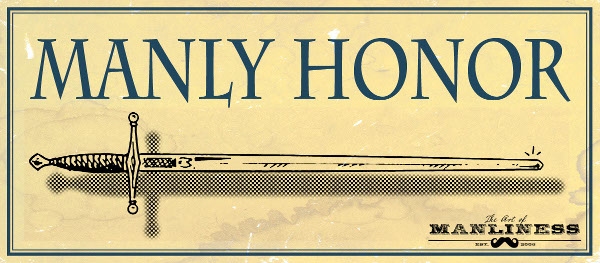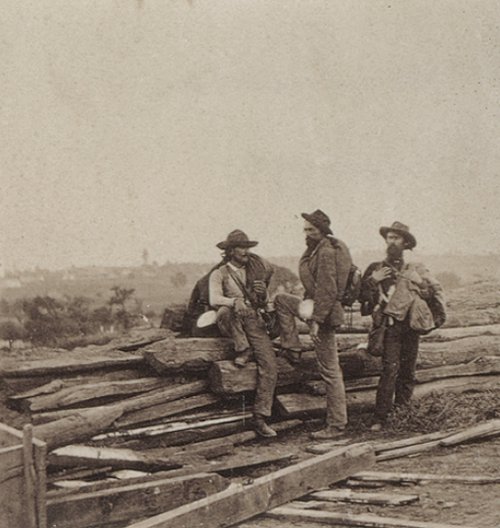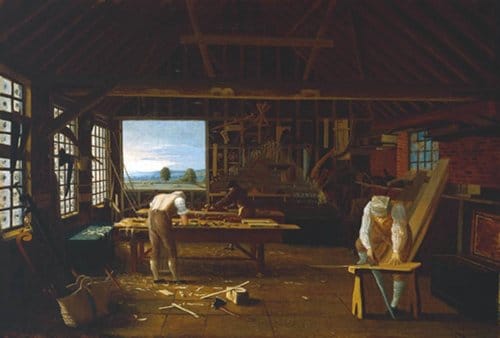
Across cultures and time, the archetype of the craftsman has represented man’s ability to create and has been the mark of mature manhood. He is homo faber — man the creator. Instead of passively consuming and letting things happen to him, the craftsman fashions the world to his liking and proactively shapes and influences it. Ancient philosophers in both the West and the East have used the craftsman as a symbol of he who contributes to his community and as an ensign of humility, self-reliance, and calm industry.
When we think of the archetypal craftsman, images of a bearded man clad in a leather apron and rolled-up sleeves, toiling away in his workshop producing beautiful and useful items comes to mind. What’s interesting is that the ancient Greeks had a much more inclusive idea of the craftsman than our modern conception. Besides masons, potters, and carpenters, the ancient Greeks included jobs now considered “knowledge professions” like doctors, legislators, and administrators under the craftsman label. Even the work of a father was considered a craft of sorts that required the same care and attention to detail as that of the carpenter. Indeed, the ancient Greeks believed that the values and ethos of craftsmanship were things all should seek to live by. In so doing, a man could achieve arete, or excellence, and thus experience eudaimonia, or a flourishing life.
Over time, the ideal of craftsmanship was cordoned off to just the technical arts. Physicians and legislators no longer thought of themselves as craftsmen, but as philosophers and natural scientists who were more concerned with the theoretical as opposed to the practical. Such a shift is a shame, for the principles of craftsmanship truly do apply to every man, whether he makes furniture or crunches numbers. Below we take a look at how these overarching principles of the traditional craftsman can apply to all areas of your life, no matter your profession.
Many of these principles are things we’ve covered before on the Art of Manliness. Make sure to explore the links within this article to more fully understand the concepts held within.
Do Things Well for the Sake of Doing Them Well
“Make every product better than it’s ever been done before. Make the parts you cannot see as well as the parts you can see. Use only the best materials, even for the most everyday items. Give the same attention to the smallest detail as you do to the largest. Design every item you make to last forever.” – Shaker Philosophy of Furniture Making
Fundamental to the code of craftsmanship is the desire to do something well for its own sake. Sure, the craftsman often gets paid for his work, but it’s not the paycheck that determines how well he does the job. A true craftsman will work until the job is done and done well, even if he’s working for free. Philosopher and motorcycle repairman Matthew B. Crawford shared a story in his book Shop Class as Soulcraft that exemplifies the craftsman’s compulsive fidelity to this ethic.
A guy had brought an old Magna motorcycle into Crawford’s shop that needed work on the clutch. Crawford could solve the clutch problem just fine, but he also noticed that the engine’s oil seal looked “buggered.” He tried to fix it but didn’t make any headway. Due to the damage and the nature of the oil seal, replacing it would require a lot of work and a lot of time. Frustrated, he left his shop for a smoke. While the smoke filled his lungs, the thought came to him that:
“The best business decision would be to forget I’d ever seen the ambiguously buggered oil seal. With a freshly rebuilt slave cylinder, the clutch worked fine. Even if my idle speculation about the weeping oil seal causing the failure of the slave cylinder seal was right, so what? It would take quite a while for the problem to reappear, and who knows if this guy would still own the bike by then. If it is not likely to be his problem, I shouldn’t make it my problem.”
But as he walked back into the shop, he couldn’t stop thinking about that buggered oil seal:
“The compulsion was setting in, and I did little to resist it. I started digging at the seal, my peripheral vision narrowing. At first I told myself it was exploratory digging. But the seal was suffering from my screwdriver, and at some point I had to drop the forensic pretense. I was going to get that little f***er out.”
Crawford goes on to explain how he’d often bill his clients fewer hours than he actually worked on a bike because of his thoroughness or just his plain curiosity of tinkering with things:
“I feel I have to meet the standards of efficiency that [an independent mechanic] set, or at least appear to. So I lie and tell people a job took ten hours when it might have taken twenty. To compensate, I also tell them my shop rate is forty dollars per hour, but it usually works out to more like twenty. I feel like an amateur, no less now than when I started, but through such devices I hope to appear like somebody who knows what he is doing, and bills accordingly.”
Money wasn’t important to Crawford, just doing the job well for the sake of doing it well was what mattered.
You can apply this craftsmanship ethic to more than just tangible objects. Even if you do more ethereal work, you can do it well for the sake of doing it well. The reward for doing an exhaustively thorough job can sometimes be monetary, but it may very well go unnoticed by one’s customer or boss. The most fulfilling reward of living by the craftsmanship ethic is the feeling of pride that comes with knowing you gave a certain job your damndest effort. It’s the unmatchable satisfaction of seeing one’s inner integrity displayed in the wholeness and quality of one’s external labor.
Plan (But Not Too Much)
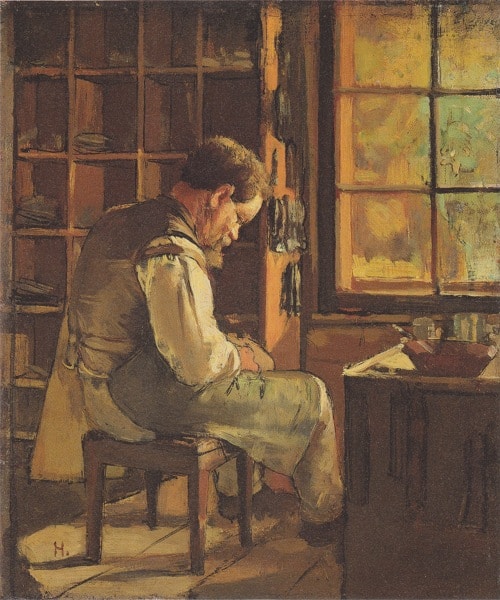
With any project, the craftsman creates twice: first mentally and then physically. Before he sets chisel to stone or hammer to wood, the craftsman has already created his work in his mind. In other words, he plans how to bring out the object from the rough materials and tools before him.
On the other hand, while the craftsman understands the importance of planning, he isn’t over-fastidious about it. Instead of detailed blueprints, the master craftsman prefers the rough sketch because he knows that unforeseen problems (or opportunities) can arise once he’s actually working. The rough sketch, philosopher Richard Sennett argues in The Craftsman, provides a “working procedure for preventing premature closure.” It gives structure, but leaves room for improvisation and change if needed.
Follow the example of the craftsman in the way you plan your life. Envision what your ideal life (and even year, week, and day) would look like and roughly sketch out how you’re going to go about making it a reality. Some folks fall into the trap of trying to plan out every. single. detail. Their over-planning often leads to frustration when things don’t exactly follow their ideal blueprint. Even worse, uncompromising attention to a highly detailed life plan can cause a man to miss out on more rewarding opportunities that he could not have foreseen ahead of time. When planning, sketch out a rough plan on the trestle board of your life and make course adjustments as you actually go about the work of living.
Measure Twice, Cut Once
This is one of the simplest and most memorable maxims of craftsmen, although it’s not always easy to follow through with in your everyday life. Suffice it to say that while you should leave room in your plans for improvisation, when it comes to making decisions that you can’t take back, make sure you’ve studied and pondered the choice thoroughly before you make your “cut.”
Work With What You Got
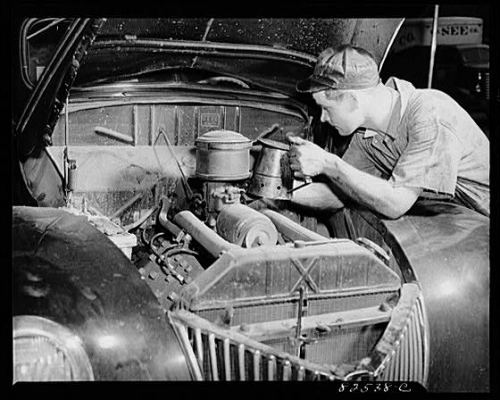
The master craftsman understands that most times he’ll never have the ideal materials, tools, or environment to work with. Unforeseen knots are discovered in wood and hidden imperfections in stone are revealed. Instead of becoming frustrated by such curveballs, the master craftsman adjusts his plans and works these imperfections into his creation so that you’d never know they were there. He can sometimes even work the imperfection into a source of strength for the piece.
Sometimes a craftsman doesn’t have the exact tool that he needs, so he improvises with what he has and learns something new in the process. As Sennett argues, “Getting better at using tools comes to us, when the tools challenge us, and this challenge often occurs just because the tools are not fit-for-purpose. They may not be good enough or it’s hard to figure out how to use them…However, we come to use it, the very incompleteness of the tool has taught us something.”
Just as the craftsman cannot exactly control what he has to work with, we cannot control every aspect of our life. We’re all given different materials and circumstances to work with. Some of us were born with physical or mental handicaps. Setbacks happen like divorce, accidents, and job layoffs. Instead of working against this resistance, embrace it like the craftsman. Instead of seeing these constraints and contingencies as obstacles, see them as creative opportunities and incorporate them into your life as unique and interesting pieces of texture. Remember, some of history’s greatest men turned what could have been a weakness into a strength.
Cultivate Patience
A good craftsman has the patience to stay with frustrating work, even when it takes longer than he originally thought. He avoids frustration by living by the following maxim: when something takes longer than you expect, stop fighting it and embrace it.
Much of our frustrations in modern life could be avoided if we would just develop this zen-like patience of the craftsman. Us moderns have a perverse expectation that things should happen NOW. We want emails answered immediately and we even expect success to come right away. Mark Zuckerberg is not your average success story, so stop trying to be like him. The reality is that things almost always take longer than expected, especially those things that are good and noble. So instead of fighting it, embrace it as the calm craftsman does. Life will become instantly more enjoyable and less stressful once you cultivate this virtue of patience.
Let Go of Your Ego
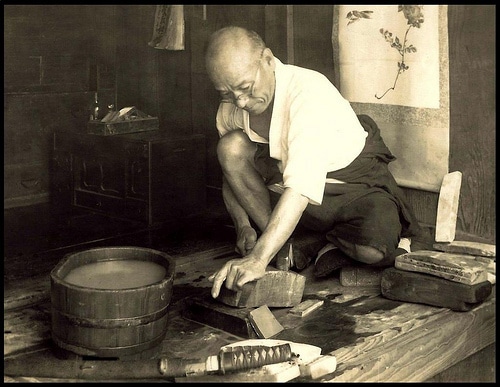
The craftsman willingly opens himself up to teaching, criticism, and judgment from his peers and clients because that’s the only way he can improve. He doesn’t take criticism personally because the craftsman is more concerned about doing good work than feeling good about his work. A true craftsman understands that nobody cares how he feels about his work. In the end he knows that the only question that matters is: “Does it work?”
According to Crawford, “the tradesman must reckon with the infallible judgment of reality, where one’s failures or shortcomings cannot be interpreted away.” The work of the craftsman isn’t wishy-washy. The craftsman must be able, as Crawford notes, to point and say, “the building stands, the car now runs, the lights are on.” Besides being able to concretely demonstrate whether his creation or repair actually succeeds, the craftsman must also face instruments that determine whether his work is “true” — the level, the square, the compass, the plumb, the ruler. There’s no fudging with these tools. The shelf a carpenter made is either level or it’s not.
Modern culture has indoctrinated us that it’s more important to feel good about our work than to actually do good work. Self-help and career books tell us that we should find work that feels “authentic.” School children are taught that the only thing that counts is their effort, not if their work is actually good or correct. Crawford calls this emphasis on feelings as opposed to results a consumer ethic as opposed to a craftsmanship ethic.
The problem with the consumer ethic is that it creates individuals with self-inflated and fragile egos who are unable to withstand the sometimes harsh criticisms and judgments that invariably come in life and in work. Clients and bosses don’t care if you felt “authentic” when writing a memo or if you tried really hard on a project. All they care about are the results. In life, it often takes mistakes in order to get better. You can’t get better if no one ever points out your failings.
If you wish to become the best man you can be, you must rid yourself of the consumer ethic of feelings and replace it with the craftsmanship ethic of results. Does your creation work? Does it look good? Does it add something to the world? If not, seek feedback and use that criticism to improve your work.
Develop Your Practical Wisdom
Through years of experience, the craftsman develops what Robert Greene calls a “masterly intuition.” He can sense problems and solutions by merely looking at an object or listening to it operate. I liken it to how a man will often know if there is something wrong with his car just by feeling the way it drives or hearing something subtle that wasn’t previously there. Crawford argues that the master craftsman’s ability to intuit and work by “hunches” allows him to “know what do when the rules run out or there are no rules in the first place.” It’s what allows a good auto mechanic to diagnose a transmission problem even when the computerized test equipment says the car’s transmission is a-okay or a carpenter to know what sort of joint would work best on a project.
Aristotle called this kind of intuition phronesis, or practical wisdom. The ancient philosopher believed that the phronesis was a virtue that all men should develop, not just carpenters or masons. Practical wisdom is what allows us to make good judgments when we face decisions when there’s no clear right or wrong answer. It gives us the ability “to do the right thing, at the right time, for the right reason.” Aristotle argued that practical wisdom for everyday life develops the same way craftsmen develop theirs — through experience and trial and error.
Mastery Brings Meaning

Mastery is the goal of the true craftsman. As an apprentice, the would-be craftsman devotes years of his life humbly submitting to quiet observation. He watches his master work and gives an attentive ear to his instructions. After years of passive observation, an apprentice begins experimenting his craft to determine his skill. Through years of trial and error, he slowly hones his skill to a sharp edge. Even when a craftsman has obtained the level of master, he continues to dedicate his life to constant improvement. He understands that by increasing his ability, he increases his value. By mastering his trade, the craftsman is better able to live by the craftsmanship ethic, which in turn allows him to feel deeper personal satisfaction, develop confidence, contribute to his community, and thus discover greater and greater meaning and fulfillment in his work.
In Drive, Daniel Pink highlights research that has shown that, contrary to popular belief, it’s not the type of work that we do that leads to personal fulfillment. Rather it’s mastery of our work (along with autonomy and purpose) that brings us satisfaction. If you feel like you’re lacking meaning in your work or in your life, follow the example of the craftsman by seeking mastery. If you’re a computer programmer, make it a goal to constantly improve your programming chops; if you’re a manager, read the latest management research and apply it in your daily work. By seeking mastery, you’ll increase your self-efficacy and your ability to leave a mark on the world.
Find Your Workshop
We often imagine the archetypal craftsman toiling alone in his shop, but historically, the vocation of a craftsman was and still is very social. When a master craftsman wanted to commune with his fellow masters, he’d head to the nearest guildhall where new insights were shared and policies governing the craft debated. And now, as then, a craftsman’s workshop is the real hub of his sociality. Here he mentors and teaches an apprentice or journeyman, works alongside his peers, and interacts with his clients.
The workshop and guildhall give the craftsman a sense of community, identity, and belonging. Crawford says this of the community that craftsmanship fosters:
“So my work situates me in a particular community. The narrow mechanical things I concern myself with are inscribed within a larger circle of meaning; they are in the service of an activity that we recognize as part of a life well lived. This common recognition, which needn’t be spoken, is the basis for a friendship that orients by concrete images of excellence.”
At its core, a craftsman’s workshop is an honor group. It’s home to a small, intimate group of men, where a code of honor — in this case, the craftsmanship ethic — guides and shapes the behavior of those within the workshop’s walls. As we’ve discussed in our post on reviving manly honor, traditional honor inspires and compels men to be the very best. The tight-knit community that honor requires serves as a check on narcissism and reminds a man that he’s not the center of the universe. More importantly, honor gives meaning to a man’s life.
Mimic the craftsman by finding your metaphorical workshop. Be intentional about forming life-long brotherhoods. Find your platoon of men that will hold you accountable to a code of honor that demands excellence and honesty in all you do.
Whether you spend your days knee-deep in sawdust, paperwork, or diapers, by adopting and living the traditional values of the craftsman you’ll find more personal fulfillment and meaning, enrich your family and community, and hammer, mold, and sculpt an indelible legacy as a man.
________________
Sources:
The Craftsman by Richard Sennett
Shop Class as Soulcraft by Matthew B. Crawford
Mastery by Robert Greene





